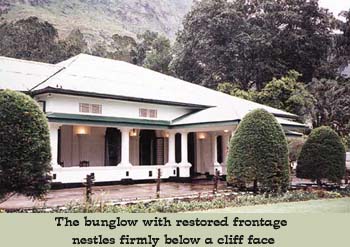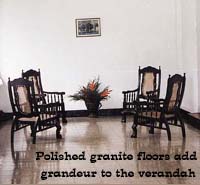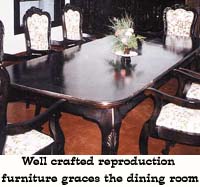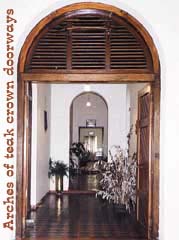

![]()
Secluded in hillside tea plantations are bungalows recalling
part of Sri Lanka's recent past. Royston Ellis and photographer
Gemunu Amarasinghe set out to discover some of them in this fortnightly
series........

Perhaps the best kept se-cret in the world of plantation bungalows is the palatial mansion that was once the home of the superintendent of Kalupahana plantation. It is not only hidden from the road (near Haputale), and has no view from where it can be seen, it is also surrounded by a high fence and has a gate opened only to authorised visitors by a uniformed security guard.
The exceptional security is because the bungalow is in the compound of a newly built green tea factory. This factory is the only one in Sri Lanka to make both Chinese and Japanese green tea under the same roof. It was set up in 1992 which is when the firm of James Finlay Ltd. acquired the seven-acre property and the bungalow.
A photograph of the bungalow then shows a house desperately in need of restoration. Walls were chipped, the roof sagged and the garden overgrown with weeds and vegetables gone to seed. Tiran Peiris, the factory manager, set about a massive restoration project to bring the bungalow back to its former glory.
Glorious it is today. Set against a backdrop of a mountain laced with
tumbling streams and soaring nearly 1,000 feet above it, the bungalow has
a magnificence unintimidated by nature's grandeur. A lawn has been relaid
and from it the full majesty of the bungalow becomes apparent.


Its portico of sturdy columns leads to a verandah not added as an afterthought but as an essential part of the house. There are no fire places within, so the builders obviously decided the bungalow's location, at over 3,000 feet above sea level, was warm enough to encourage verandah living. A terrazo floor adds shine to the pristine atmosphere of its extensive length.
Curiously the portico does not give direct access to the bungalow's main door and entrance corridor but to a door opening into the sitting room. This, like all its verandah doors, nestles in a doorway surmounted by a gothic arch of teak louvers. The sitting room's dominant feature is the ceiling, also of teak, contrasting with the room's plain white walls.
A second access to the sitting room is from the main entrance corridor
which delves through the three stages of the house to terminate in the
servants quarters. On the other side of the corridor is the huge master
bedroom, reserved for visiting company officials. It has a separate entrance
from the verandah and another splendid wooden board ceiling.
The second part of the house begins through an archway with the dining room on the right. This is even larger than the bedroom, perhaps 20 feet by 25 feet, and has a ceiling that has yet to be restored to its original beauty. It is made entirely of copper in traditional Empress floral designs but retains the white paint daubed on it years ago.
A corridor at right angles skirts the sitting room giving access to two minor bedrooms and a second entrance hall, with a door from the verandah. Like an annexe to the bungalow, here is a second master bedroom with the same high ceiling of teak of the other main rooms.
Part three of this airy mansion is dedicated to the servants who in colonial days must have numbered two or more. Now Mr& Mrs Peiris make do with one since this is no longer an estate bungalow that traditionally had two indoor servants provided by the management company, but a more modest operation.
Cost-effectiveness is not the only modern trend in this remarkable bungalow: the furniture commands a second look. It is not the worn and rickety relics found in many properties: it is all brand new. However, every piece has been carefully handcrafted in period style, so it matches and even enhances the restoration of the bungalow as a whole. The huge sideboard in the dining room is a work of art smoothly made with mahogany and surely destined to become a valuable antique 100 years hence.
It is careful preservation like this of plantation bungalows that will ensure there is still evidence of Sri Lanka' s plantation heritage in the next century.
Continue to Plus page 6 * Oh! to walk freely and talk freely
Return to the Plus contents page
![]()
| HOME PAGE | FRONT PAGE | EDITORIAL/OPINION | NEWS / COMMENT | BUSINESS
Please send your comments and suggestions on this web site to
info@suntimes.is.lk or to
webmaster@infolabs.is.lk